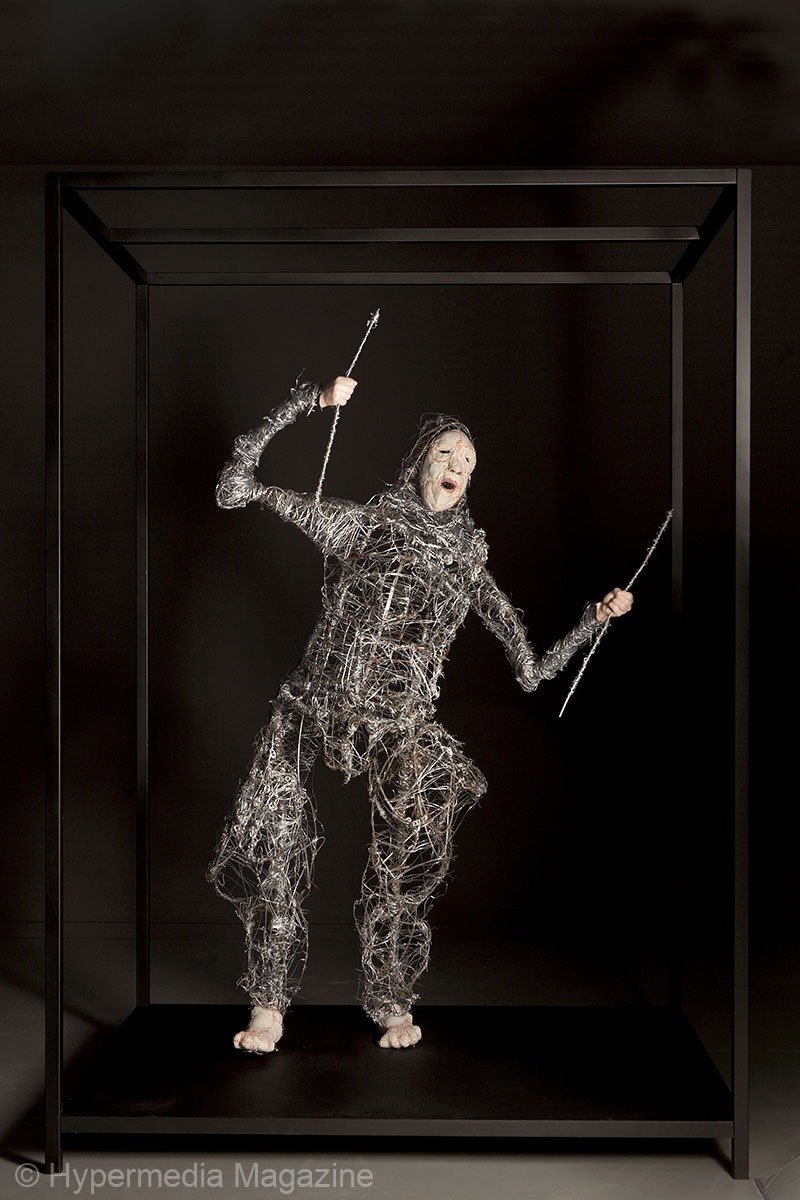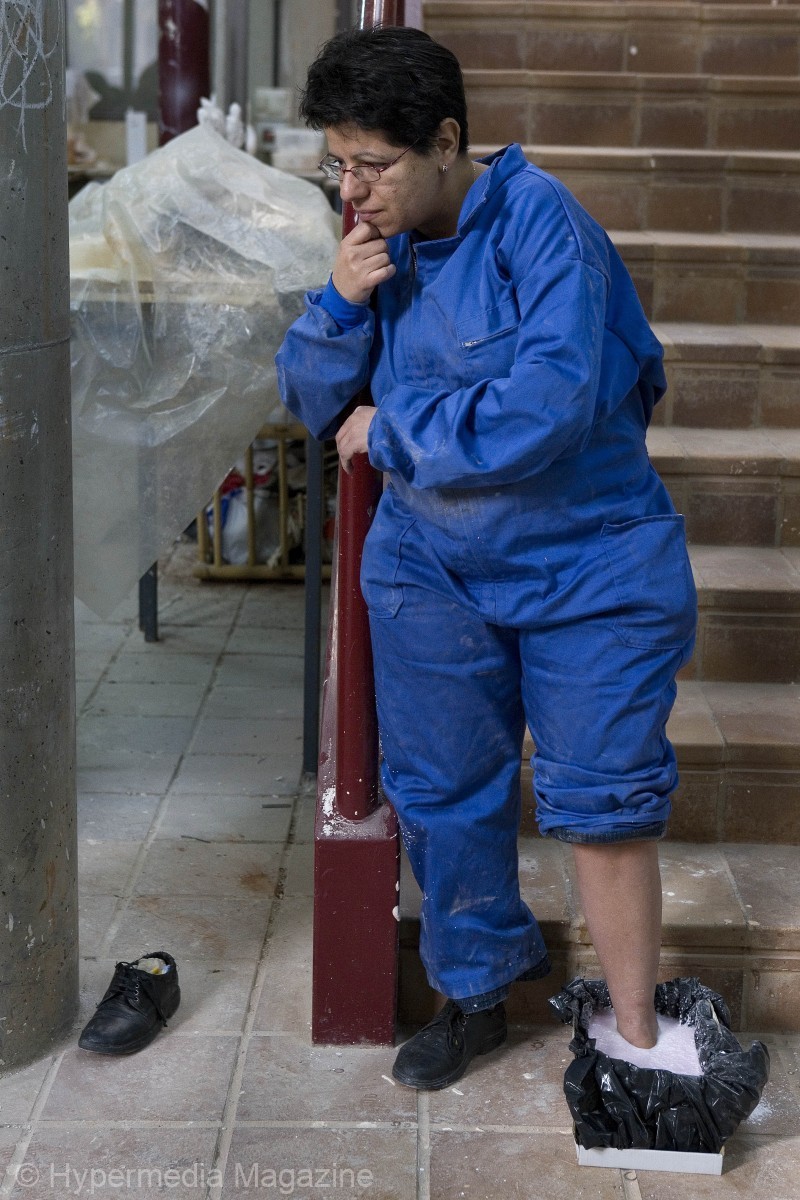Muy al principio, a poco de empezar en Debajo del Sombrero, Belén Sánchez (Madrid, 1972) realizó un collage. Como en el taller había una cámara de video, al terminar dijo: “Vamos a hacer la película”.
Mientras la cámara recorría la escena —que representaba a Belén tumbada en una camilla, desnuda, con el cuerpo roto, y tres personajes salvadores detrás—, ella iba moviendo el collage, primero en vaivén, luego con movimientos bruscos y cortos, dando la impresión de que la figura tumbada sufría una convulsión.
Entraba así Belén en una dimensión nueva. Haciendo palanca abría un mínimo hueco en el tiempo en busca de esa maravilla del cine que es “dar vida”.
Belén da vida a todos los personajes de sus películas, actuándolos directamente o a través de esculturas, representaciones de su propio cuerpo, que ella misma realiza. Pero más que una cineasta, es una performer. Durante el rodaje, Belén se desentiende de la realización, su interés se concentra por entero en la actuación, en la acción.
Su trabajo plástico: los dibujos, la infinidad de collages recreando diferentes escenas que hace para cada película. Las esculturas, en ocasiones tan laboriosas que le pueden llevar varios años. Todo está interconectado, porque todo conforma un espacio de acción vivida que le permite revivir, repasando una y otra vez episodios atrapados en su memoria.
Belén Sánchez crea historias. Sus historias son diferentes versiones construidas alrededor de una secuencia que siempre se repite: agresión, curación y castigo de los malos. Su cuerpo desnudo es el centro de la acción. Es su cuerpo el que va a sufrir la agresión y el que posteriormente será curado.
Pero Belén no se coloca solo en el sitio de la víctima, también los que curan y los agresores son ella. Suya es la bondad de los buenos y la maldad de los malos. Y aunque al final el mal es reparado y los malos reciben su merecido castigo, Belén no tiene reparo alguno en entrar en la fascinación que la maldad tiene.
No hay vergüenza ni pudor en su obra, no hay juicio y no hay culpa. Y así Belén puede atravesar las sombras de la violencia, sumergirse en el goce que la violencia proporciona y salir resplandeciente de inocencia.
Lola Barrera Lemus y Luis Sáez.
Directores Estudio Debajo del Sombrero
Belén Sánchez (galería)
Portraits Under the Hat: Belén Sánchez
During one of her early days at Debajo del sombrero, Belén Sánchez (Madrid, 1972) made a collage.—“Let’s film it!”, she declared after finishing, so we grabbed one of the cameras we had in the workshop.
While the camera hovered over the scene, which featured her as the central figure, laid on a stretcher with a battered body, and three protective characters in the background, Belén moved the pieces of the collage, gently rocking them back and forth at first, and then shifting them in short and violent jerks, making it seem as if her character was suffering a seizure. She was entering a new artistic dimension. Leveraging the initial artwork, the collage, she had managed to engage the domain of time, seeking the life-giving quality of cinema.
Belén breathes life into all of the characters in her films, either performing them herself or using sculpture as a medium to represent her own body. But rather than a filmmaker, she is a performer. During filming, she disregards the technical aspects of production, focusing instead entirely on performance, on action.
Her plastic work —the myriad of drawings and collages, each recreating a scene, that she makes for her films, the laborious sculptures that sometimes take years to complete—, is all connected to her drive towards action and performance: it all constitutes a space for action, where she can relive, over and over again, the chapters of her memory.
Belén creates stories, or different versions of the same story, the same sequence: aggression, healing and the eventual punishment of the aggressors, the “bad guys”. In this sequence, her naked body is the centre of the action: it will be the object of the aggression but it will also be healed.
But she is not just the victim in these scenes, she also performs the roles of the healers and the aggressors. Her performance is equally involved with the goodness of the former and the evil of the latter, and, although the moral conflict is always positively resolved, she doesn’t hesitate to embrace her fascination for evil and violence for the duration of it. So, she is able to wander through the pits of violence, exhaust the pleasure that violence affords, and emerge with a newfound innocence.
Lola Barrera Lemus and Luis Saez
Dir. Studio Debajo del Sombrero

Federico García Cortiza y su ‘expresionismo biológico’
“Buscaba un modo de trabajar directo, a lápiz, que el dibujo se percibiera y que en cualquier lugar que llegara pudiera coger un pedazo de cartón y un lápiz para ponerme a dibujar. Me parece más complejo dibujar que pintar”.





























